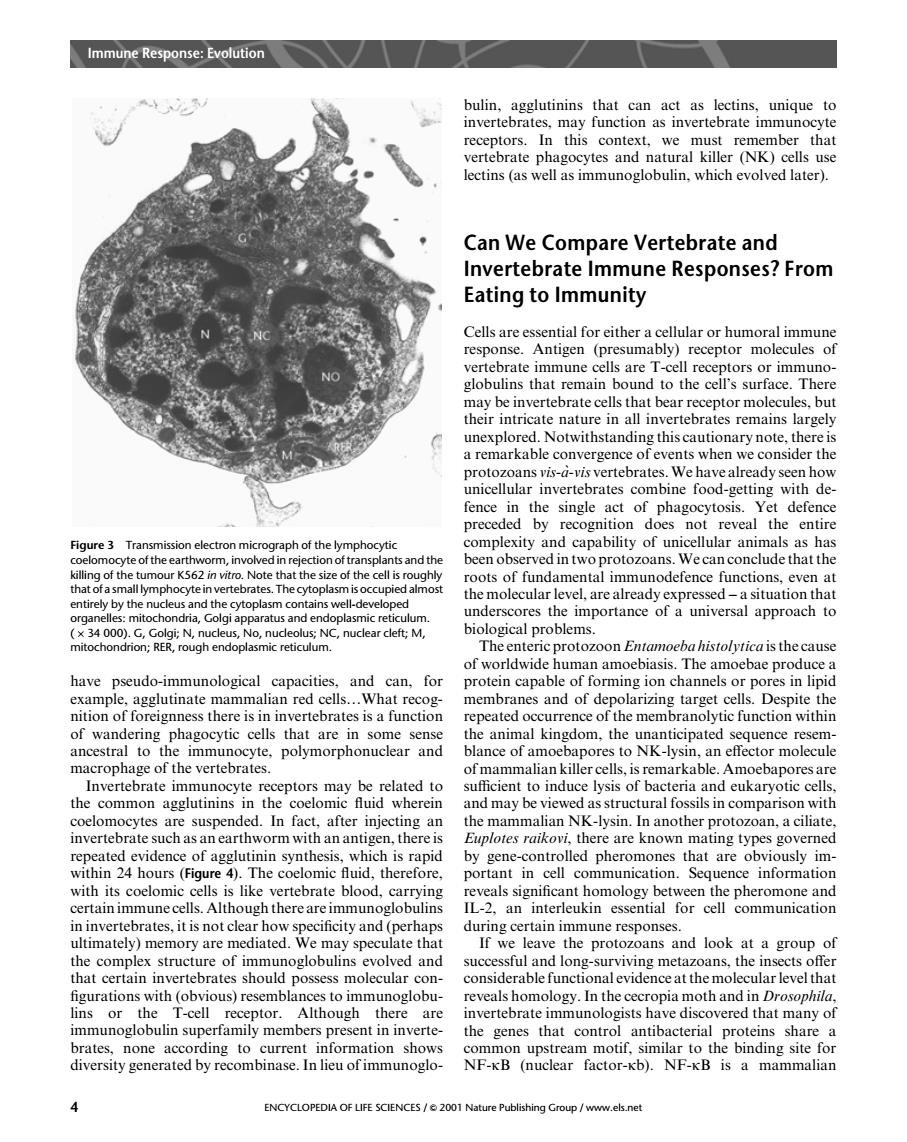正在加载图片...

ImmunpEvolution bulin.agglutinins that can act as lectins.unigue to invertebrates.may function as invertebrate immunocyte tha ved later) Can We Compare Vertebrate and Invertebrate Immune Responses?From Eating to Immunity Cells are e Anti There a remarkable convergence of events when we consider the e food-getting w灯 d eal the of the ompieaiyandcapebiyofnicellhranimasashes n of ts and the been observed in two protozoans.Wecan conclude that the ocyte cytoplasm even at ochondria. paratu rtance and e res them och to biological problems The enteric protozoon Entamoebahistolyticais the cause have pseudo-immunological capacitie for ein cap man amoe The amoebae pro amoeegneweargicSiesNahC malia and of d peated occurrence of the function within of wandering phagocytic cells that are in some sense sem 9 unocyte,polymorph nce o am pore r molecu Invertebrate immunocyte receptors may ommaanee.5aabeAmcbap0 the common agglutinins in the coelomic fuid wherein and may be viewed as structural fossils in comparison with the mammalian NK-lysin.In another protozoan,a ciliate, nvert utin: m ere are es go n within 24 hours (Figure 4). rant in cell communication.Seq nce informat with its coelomic cells is like vertebrate blood,carrying veals significant homology between the pheromone and ough there are immunoglobulins an interleukin essential for cell communication rates,it is not clear ted.Wc ty and mune respons nd look at a the complex olved and sful and lon ng metazoans the ins that certain invertebrates should possess molecular con considerable functionalevidence at the molecular level that noglobu reveals homology.In the n or ny c li are h rial s.none according to current information show stream motif similar to the bindine site for diversity generated by recombinase.In lieu ofimmunoglo- NF-KB (nuclear factor-kb).NF-kB is a mammalian ENCYCLOPEDIA OF LIFEhave pseudo-immunological capacities, and can, for example, agglutinate mammalian red cells_What recognition of foreignness there is in invertebrates is a function of wandering phagocytic cells that are in some sense ancestral to the immunocyte, polymorphonuclear and macrophage of the vertebrates. Invertebrate immunocyte receptors may be related to the common agglutinins in the coelomic fluid wherein coelomocytes are suspended. In fact, after injecting an invertebrate such as an earthworm with an antigen, there is repeated evidence of agglutinin synthesis, which is rapid within 24 hours (Figure 4). The coelomic fluid, therefore, with its coelomic cells is like vertebrate blood, carrying certain immune cells. Although there are immunoglobulins in invertebrates, it is not clear how specificity and (perhaps ultimately) memory are mediated. We may speculate that the complex structure of immunoglobulins evolved and that certain invertebrates should possess molecular con- figurations with (obvious) resemblances to immunoglobulins or the T-cell receptor. Although there are immunoglobulin superfamily members present in invertebrates, none according to current information shows diversity generated by recombinase. In lieu of immunoglobulin, agglutinins that can act as lectins, unique to invertebrates, may function as invertebrate immunocyte receptors. In this context, we must remember that vertebrate phagocytes and natural killer (NK) cells use lectins (as well as immunoglobulin, which evolved later). Can We Compare Vertebrate and Invertebrate Immune Responses? From Eating to Immunity Cells are essential for either a cellular or humoral immune response. Antigen (presumably) receptor molecules of vertebrate immune cells are T-cell receptors or immunoglobulins that remain bound to the cell’s surface. There may be invertebrate cells that bear receptor molecules, but their intricate nature in all invertebrates remains largely unexplored. Notwithstanding this cautionary note, there is a remarkable convergence of events when we consider the protozoans vis-a`-vis vertebrates.We have already seen how unicellular invertebrates combine food-getting with defence in the single act of phagocytosis. Yet defence preceded by recognition does not reveal the entire complexity and capability of unicellular animals as has been observed in two protozoans.We can conclude that the roots of fundamental immunodefence functions, even at the molecular level, are already expressed – a situation that underscores the importance of a universal approach to biological problems. The enteric protozoonEntamoeba histolytica is the cause of worldwide human amoebiasis. The amoebae produce a protein capable of forming ion channels or pores in lipid membranes and of depolarizing target cells. Despite the repeated occurrence of the membranolytic function within the animal kingdom, the unanticipated sequence resemblance of amoebapores to NK-lysin, an effector molecule of mammalian killer cells, is remarkable. Amoebapores are sufficient to induce lysis of bacteria and eukaryotic cells, and may be viewed as structural fossils in comparison with the mammalian NK-lysin. In another protozoan, a ciliate, Euplotes raikovi, there are known mating types governed by gene-controlled pheromones that are obviously important in cell communication. Sequence information reveals significant homology between the pheromone and IL-2, an interleukin essential for cell communication during certain immune responses. If we leave the protozoans and look at a group of successful and long-surviving metazoans, the insects offer considerable functional evidence at the molecular level that reveals homology. In the cecropia moth and in Drosophila, invertebrate immunologists have discovered that many of the genes that control antibacterial proteins share a common upstream motif, similar to the binding site for NF-kB (nuclear factor-kb). NF-kB is a mammalian Figure 3 Transmission electron micrograph of the lymphocytic coelomocyte of the earthworm, involved in rejection of transplants and the killing of the tumour K562 in vitro. Note that the size of the cell is roughly that of a small lymphocytein vertebrates.The cytoplasm is occupied almost entirely by the nucleus and the cytoplasm contains well-developed organelles: mitochondria, Golgi apparatus and endoplasmic reticulum. ( 34 000). G, Golgi; N, nucleus, No, nucleolus; NC, nuclear cleft; M, mitochondrion; RER, rough endoplasmic reticulum. Immune Response: Evolution 4 ENCYCLOPEDIA OF LIFE SCIENCES / & 2001 Nature Publishing Group / www.els.net